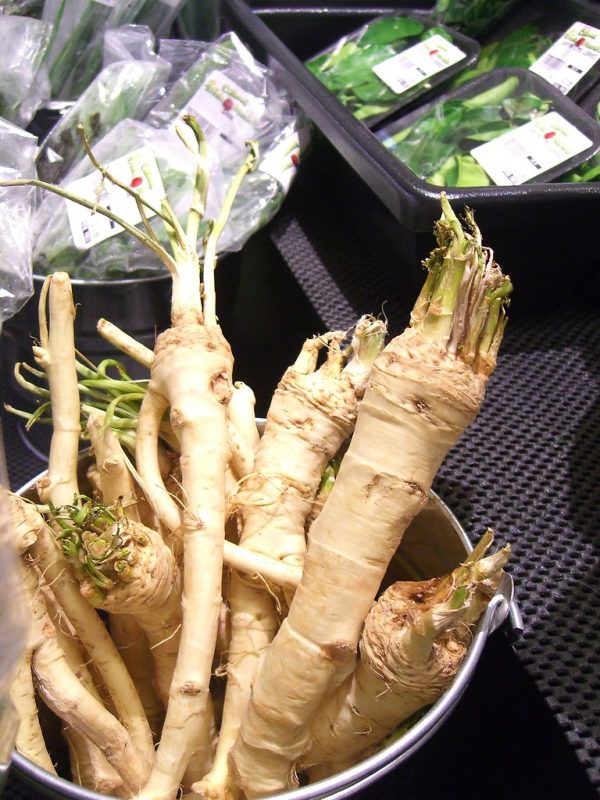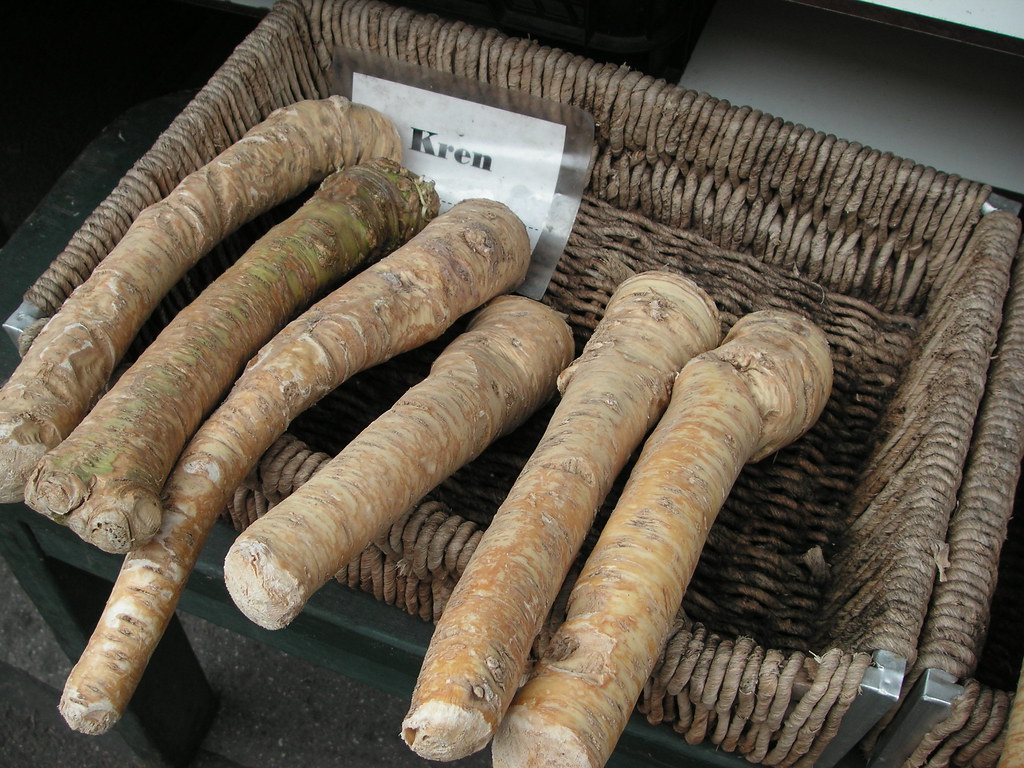In this guide, we’ll cover everything you need to know about harvesting horseradish, from selecting the right plants to methods for preparation and storage.
What is Horseradish?

Horseradish (Armoracia rusticana) is a perennial plant with large, broad leaves and a thick, white root that boasts a sharp, spicy flavor. It is commonly used as a condiment, often found in sauces, dressings, and dips. Its strong flavor comes from glucosinolates, compounds that produce its distinctive kick. Besides its culinary uses, horseradish also offers potential health benefits, including anti-inflammatory properties and antioxidants.
Growing Horseradish
Before focusing on the harvesting process, it’s essential to understand the growth conditions for horseradish. This plant thrives in well-drained soil with plenty of sunlight. Planting horseradish is simple—just ensure you have a root cutting, often called a crown, which should be planted about 2 inches deep in the spring or fall. The leaves will grow rapidly, while the roots will begin to thicken beneath the soil.
Choosing the Right Time to Harvest
The timing of your horseradish harvest significantly impacts the flavor and quality. Horseradish is typically harvested in late fall after the first frost or early spring before new growth starts. Harvesting in the fall allows the roots to develop more flavor due to the cold, which intensifies their heat. Spring harvesting can yield milder roots, especially if done before flowering.
Signs That Your Horseradish is Ready to Harvest
Root Size: When the roots are about 1 to 2 inches in diameter, they are generally ready for harvesting. If the roots are small, allow them more time to grow.
Leaf Health: Leaves will start to yellow and die back in the fall. If you notice this change, it could be an indication that the roots have matured.
Seasonal Indicators: A light frost can signify that it’s time to harvest, as the cold can make the roots spicier.
How to Harvest Horseradish
Preparing for the harvest requires some tools and techniques to ensure you get the best roots without damaging them.
Tools You’ll Need
A garden fork or spade
A sharp knife
A clean cloth or sponge
A garden bucket
Step-by-Step Harvesting Process
Gather Your Tools: Make sure you have your garden fork or spade, a sharp knife, and a container for collecting your roots.
Loosen the Soil: Carefully insert the garden fork around the base of the plant to loosen the soil. Be cautious not to pierce the roots. Start about a foot away from the plant base and work your way inward.
Pull the Root: Grip the base of the plant, pulling gently but firmly. If the root seems stuck, continue to loosen the soil around it.
Cut the Leaves: If the leaves are overly long or cumbersome, trim them back using your knife, but leave about an inch of stem for easy handling.
Clean the Roots: Once harvested, rinse the roots under cool water to remove soil. Avoid using soap as it may affect the horseradish’s flavor. A brush can assist in scrubbing off stubborn dirt.
Trim and Store: Remove any remaining leaf stubs, and trim the roots to your desired length. Store them in a cool, dark place, preferably in a cardboard box layered with sand or sawdust to prevent moisture. This helps extend their shelf life.
Storage Tips for Horseradish
If you have more horseradish than you can use right away, consider these storage tips:
Whole Roots
Cool and Dark Place: Store unprocessed roots in a cool, dark place, like a basement or root cellar, where they can last for several months.
Moisture Control: Ensure the storage environment has low humidity to prevent rotting. Placing the roots in a box with dry sand can help absorb excess moisture.
Grated Horseradish
Refrigeration: As mentioned, fresh grated horseradish should be stored in a glass jar in the refrigerator.
Freezing: For longer storage, you can freeze grated horseradish. Use an ice cube tray to freeze small portions, then transfer them to a sealed container or freezer bag. They can be easily added to soups, stews, or sauces directly from the freezer.
Processing Fresh Horseradish
If you’re eager to enjoy the spicy taste of fresh horseradish, it’s best to process it soon after harvest. Here’s how you can prepare it for immediate use or for long-term storage.
Grating Horseradish
Select Fresh Roots: Use only healthy, firm roots for the best flavor.
Peel the Skin: Use a vegetable peeler or knife to remove the skin from the horseradish root.
Grate: Use a box grater or a food processor to grate the root. Be aware that grating horseradish releases potent fumes, so be prepared for a tearful experience!
Mix with Vinegar: After grating, mix the horseradish with a little vinegar to stabilize its flavor and color. This prevents it from turning brown as it oxidizes.
Jar and Store: Store the grated horseradish in glass jars in the refrigerator. It will retain its flavor and freshness for several weeks, although its intensity may diminish over time.
Making Horseradish Sauce
If you want to enjoy horseradish in a more polished form, consider making horseradish sauce, which pairs well with meats, seafood, and sandwiches.
Ingredients:
1 cup freshly grated horseradish
1 cup sour cream or Greek yogurt
1-2 tablespoons white vinegar (to taste)
Salt to taste
Optional: A dash of sugar or lemon juice for added flavor
Instructions:
Combine Ingredients: In a bowl, mix the grated horseradish with sour cream or yogurt.
Add Vinegar: Stir in the vinegar; its acidity helps enhance the flavor while preventing browning.
Season: Add salt and any optional ingredients.
Taste and Adjust: Adjust the seasoning according to your preference.
Refrigerate: Store the sauce in an airtight container in the fridge for up to two weeks.
Culinary Uses of Horseradish
The culinary uses of horseradish are nearly limitless. Its sharp, spicy flavor can enhance many dishes:
Condiments: Use freshly grated horseradish as a condiment for meats like roast beef or ham.
Dressings: Mix it into salad dressings for an unexpected kick.
Seafood: Serve with oysters, shrimp, or fish.
Soups: Add grated horseradish to your favorite soup recipes for added flavor.
Cocktails: Try a spoonful in your next Bloody Mary for a spicy twist.
Conclusion
Harvesting horseradish is a rewarding process that adds unique flavor and heat to your culinary repertoire. Whether you’re growing it in your backyard garden or purchasing it from a local market, understanding when and how to harvest is critical to enjoying its full flavor potential. With the proper tools and techniques, you’ll be able to enjoy freshly grated horseradish in various dishes, preserving the enjoyment of this distinctive root throughout the seasons.
So, take advantage of this robust plant—get growing, harvesting, and experimenting with horseradish in your kitchen. Each dish that features this spicy addition is sure to be elevated, bringing warmth and personality to your meals





